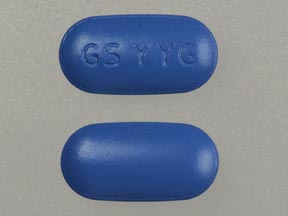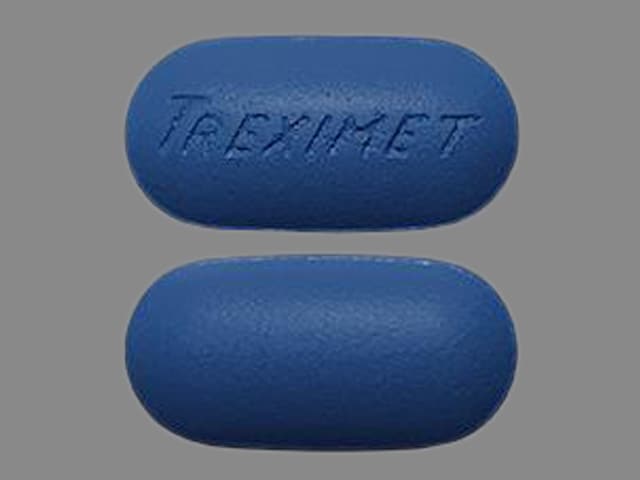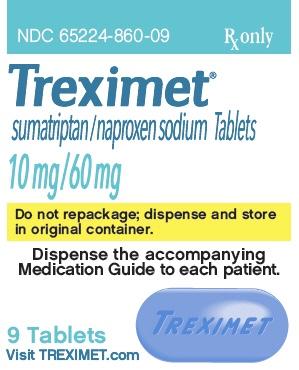What is Treximet?
Treximet is a prescription medicine that contains sumatriptan and naproxen sodium (an NSAID). Treximet is used to treat acute migraine headaches with or without aura in patients 12 years of age and older.
Treximet is not used to treat other types of headaches such as hemiplegic (that make you unable to move on one side of your body) or basilar (rare form of migraine with aura) migraines.
Treximet is not used to prevent or decrease the number of migraine headaches you have.
It is not known if Treximet is safe and effective to treat cluster headaches.
What is the most important information I should know about Treximet?
Treximet may increase your chance of a heart attack or stroke that can lead to death. Treximet contains 2 medicines: sumatriptan and naproxen sodium (a nonsteroidal anti-inflammatory drug [NSAID]).
- This risk may happen early in treatment and may increase:
- with increasing doses of NSAIDs
- with longer use of NSAIDs
Do not take Treximet right before or after a heart surgery called a "coronary artery bypass graft (CABG)."
Avoid taking Treximet after a recent heart attack, unless your healthcare provider tells you to. You may have an increased risk of another heart attack if you take NSAIDs after a recent heart attack.
Stop taking Treximet and get emergency help right away if you have any of the following symptoms of a heart attack or stroke:
- discomfort in the center of your chest that lasts for more than a few minutes, or that goes away and comes back
- severe tightness, pain, pressure, or heaviness in your chest, throat, neck, or jaw
- pain or discomfort in your arms, back, neck, jaw, or stomach
- shortness of breath with or without chest discomfort
- breaking out in a cold sweat
- nausea or vomiting
- feeling lightheaded
- weakness in one part or on one side of your body
- slurred speech
Treximet is not for people with risk factors for heart disease unless a heart exam is done and shows no problem. You have a higher risk for heart disease if you:
- have high blood pressure
- smoke
- have diabetes
- have high cholesterol levels
- are overweight
- have a family history of heart disease
Treximet can cause ulcers and bleeding in the stomach and intestines at any time during your treatment.
Ulcers and bleeding can happen without warning symptoms and may cause death.
Your chance of getting an ulcer or bleeding increases with:
- past history of stomach ulcers, or stomach or intestinal bleeding with use of NSAIDs
- the use of medicines called "corticosteroids," "anticoagulants," and antidepressant medicines called "SSRIs" or "SNRIs"
- more frequent use
- drinking alcohol
- having poor health
- advanced liver disease
- bleeding problems
- longer use
- smoking
- older age
Treximet may cause serious allergic reactions or serious skin reactions that can be life-threatening. Stop taking Treximet and get emergency help right away if you develop:
- sudden wheezing
- rash
- problems breathing or swallowing
- blisters or bleeding of your lips, eye lids, mouth, nose, or genitals
- swelling of your lips, tongue, throat or body
- fainting
- reddening of your skin with blisters or peeling
Treximet should only be used exactly as prescribed, at the lowest dose possible for your treatment, and for the shortest time needed.
Treximet already contains an NSAID (naproxen). Do not use Treximet with other medicines to lessen pain or fever or with other medicines for colds or sleeping problems without talking to your healthcare provider first, because they may contain an NSAID also.
Who should not take Treximet?
Do not take Treximet if you have:
- heart problems, history of heart problems, or right before or after heart bypass surgery
- had a stroke, transient ischemic attack (TIAs), or problems with your blood circulation
- hemiplegic migraines or basilar migraines. If you are not sure if you have these types of migraines, ask your healthcare provider.
- narrowing of blood vessels to your legs and arms (peripheral vascular disease), stomach (ischemic bowel disease), or kidneys
- uncontrolled high blood pressure
- taken any medicines in the last 24 hours that are called 5-HT1 agonists that are triptans or contain ergotamine. Ask your healthcare provider for a list of these medicines if you are not sure.
- taken an antidepressant medicine called a monoamine oxidase (MAO) inhibitor within the last 2 weeks. Ask your healthcare provider for a list if you are not sure.
- had an asthma attack, hives, or other allergic reaction with aspirin or any other NSAID medicine
- an allergy to sumatriptan, naproxen, or any of the ingredients in Treximet. See "What are the ingredients in Treximet?" below for a complete list of ingredients.
- third trimester of pregnancy
- liver problems
What should I tell my healthcare provider before taking Treximet?
Before you take Treximet, tell your healthcare provider about all of your medical conditions, including if you:
- have high blood pressure
- have asthma
- have high cholesterol
- have diabetes
- smoke
- are overweight
- have heart problems or a family history of heart problems or stroke
- have kidney problems
- have liver problems
- have had epilepsy or seizures
- are not using effective birth control
- are pregnant, think you might be pregnant, or are trying to become pregnant. Treximet should not be used by pregnant women during the third trimester of their pregnancy.
- are breastfeeding or plan to breastfeed. The components of Treximet pass into your breast milk and may harm your baby. Talk with your healthcare provider about the best way to feed your baby if you take Treximet.
Tell your healthcare provider about all the medicines you take, including prescription and over-the-counter medicines, vitamins, and herbal supplements.
Treximet and certain other medicines can affect each other, causing serious side effects.
How should I take Treximet?
- Certain people should take their first dose of Treximet in their healthcare provider's office or in another medical setting. Ask your healthcare provider if you should take your first dose in a medical setting.
- Take Treximet exactly as your healthcare provider tells you to take it.
- Take Treximet tablets whole with water or other liquids.
- Treximet can be taken with or without food.
- If you do not get any relief after your first dose, do not take a second dose without first talking with your healthcare provider.
- If your headache comes back or you only get some relief from your headache:
- For adults: a second dose may be taken 2 hours after the first dose. Do not take more than 2 doses of Treximet 85/500 mg in a 24-hour period.
- For children 12 to 17 years of age: it is not known if taking more than 1 dose of Treximet in 24 hours is safe and effective. Talk to your healthcare provider about what to do if your headache does not go away or comes back.
- If you take too much Treximet, call your healthcare provider or go to the nearest hospital emergency room right away.
- You should write down when you have headaches and when you take Treximet so you can talk with your healthcare provider about how Treximet is working for you.
What should I avoid while taking Treximet?
Treximet can cause dizziness, weakness, or drowsiness. If you have these symptoms, do not drive a car, use machinery, or do anything where you need to be alert.
What are the possible side effects of Treximet?
Treximet may cause serious side effects. See "What is the most important information I should know about Treximet?"
These serious side effects include:
- changes in color or sensation in your fingers and toes (Raynaud's syndrome)
- new or worse high blood pressure
- heart failure from body swelling (fluid retention)
- kidney problems including kidney failure
- low red blood cells (anemia)
- liver problems including liver failure
- asthma attacks in people who have asthma
- stomach and intestinal problems (gastrointestinal and colonic ischemic events). Symptoms of gastrointestinal and colonic ischemic events include:
- sudden or severe stomach pain
- weight loss
- constipation or diarrhea
- fever
- stomach pain after meals
- nausea or vomiting
- bloody diarrhea
- problems with blood circulation to your legs and feet (peripheral vascular ischemia). Symptoms of peripheral vascular ischemia include:
- cramping and pain in your legs or hips
- feeling of heaviness or tightness in your leg muscles
- burning or aching pain in your feet or toes while resting
- numbness, tingling, or weakness in your legs
- cold feeling or color changes in 1 or both legs or feet
- medication overuse headaches. Some people who use too many Treximet tablets may have worse headaches (medication overuse headache). If your headaches get worse, your healthcare provider may decide to stop your treatment with Treximet.
- serotonin syndrome. Serotonin syndrome is a rare but serious problem that can happen in people using Treximet, especially if Treximet is used with antidepressant medicines called SSRIs or SNRIs.
Stop taking Treximet and call your healthcare provider right away if you have any of the following symptoms of serotonin syndrome:- changes in blood pressure
- tight muscles
- mental changes such as seeing things that are not there (hallucinations), agitation, or coma
- fast heartbeat
- high body temperature
- trouble walking
- seizures. Seizures have happened in people taking sumatriptan, one of the ingredients in Treximet, who have never had seizures before. Talk with your healthcare provider about your chance of having seizures while you take Treximet.
The most common side effects of Treximet include:
- dizziness
- pain, discomfort, or stiffness in your neck, throat, jaw, or chest
- tingling or numbness in your fingers or toes
- dry mouth
- heartbeat problems
- feeling weak, drowsy, or tired
- nausea
- heartburn
- feeling hot
- muscle tightness
Stop Treximet and call your healthcare provider right away if you have any of the following symptoms:
- nausea that seems out of proportion to your migraine
- vomit blood
- yellow skin or eyes
- more tired or weaker than usual
- itching
- swelling of the arms, legs, hands, and feet
- sudden or severe stomach pain
- blood in your bowel movement or it is black and sticky like tar
- unusual weight gain
- flu-like symptoms
- diarrhea
- tenderness in your upper right side
Tell your healthcare provider if you have any side effects that bother you or do not go away.
These are not all of the side effects of Treximet. For more information, ask your healthcare provider or pharmacist.
Call your doctor for medical advice about side effects. You may report side effects to FDA at 1-800-FDA-1088.
Treximet Images
General information about the safe and effective use of Treximet
Medicines are sometimes prescribed for purposes other than those listed in a Medication Guide. Do not use Treximet for a condition for which it was not prescribed. Do not give Treximet to other people, even if they have the same problem you have. It may harm them.
This Medication Guide summarizes the most important information about Treximet. If you would like more information, talk with your healthcare provider. You can ask your healthcare provider or pharmacist for information about Treximet that is written for healthcare professionals.
For more information call 1-800-793-2145 or visit www.TREXIMET.com.
How should I store Treximet?
Store Treximet at room temperature between 68°F to 77°F (20°C to 25°C).
Keep Treximet and all medicines out of the reach of children.
What are the ingredients in Treximet?
Active ingredients: sumatriptan succinate and naproxen sodium.
Inactive ingredients in all strengths: croscarmellose sodium, dibasic calcium phosphate, FD&C Blue No. 2, magnesium stearate, microcrystalline cellulose, povidone, sodium bicarbonate, talc, and titanium dioxide.
85/500-mg tablets also contain: hypromellose and triacetin.
10/60-mg tablets also contain: polyethylene glycol and polyvinyl alcohol.







